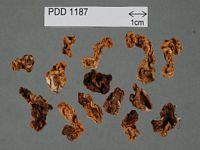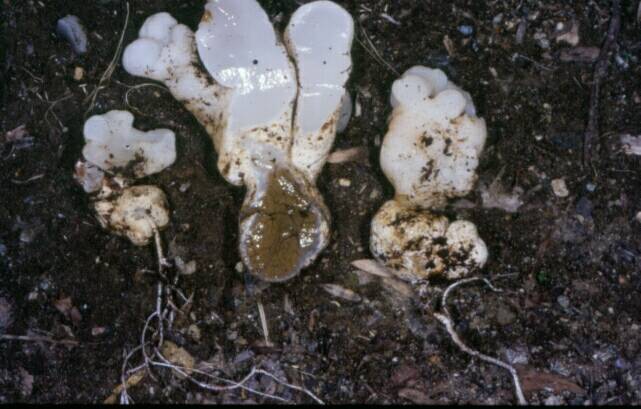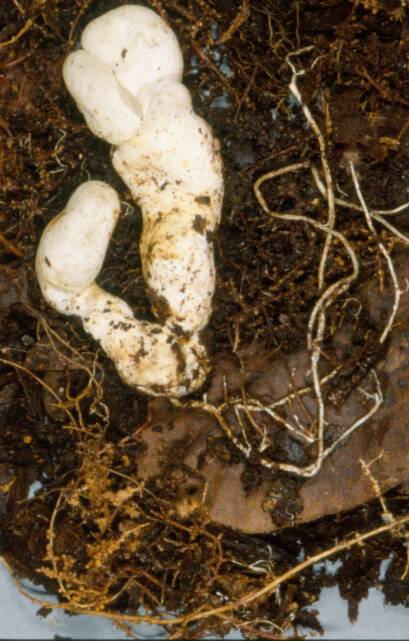|
 Phallobata alba Phallobata alba
SynonymsHysterangium lobatum
BiostatusPresent in region - Indigenous. Endemic
Images (click to enlarge)
Caption: Dried type speicimen
Owner: Herb PDD | 
Caption: Dried type specimen
Owner: Herb PDD | 
Caption: Fig. 9 Phallobata alba. A, Basidioma exterior with portion of lobe sliced to expose gleba
(PDD 47823). B, Basidioma sliced through glebal region and sterile lobes (PDD 56745). C,
Basidiospores by bright field (PDD 1187 ). D, Basidiospores by SE | 
Owner: Peter Johnston | 
Caption: PDD 76197
Owner: R.E. Beever | 
Caption: Fig. 1. Selected plants natural size: showing variation in size and shape of plants, and
especially of the lobes so characteristic of the genus. | 
Caption: Fig. 2. Section of plants x2, showing structure of lobes and gleba. | 
Caption: Section of plant, X 6 : en, endoperidium ; ex, exoperidium; l, sterile lobed portion ; bas;
sterile base, tr, trabecula. | |
Article: Castellano, M.A.; Beever, R.E. (1994). Truffle-like Basidiomycotina of New Zealand: Gallacea, Hysterangium, Phallobata, and Protubera. New Zealand Journal of Botany 32(3): 305-328 (http://www.rsnz.org/publish/abstracts.php).
Description: Basidiomata to 4.5 cm diam., variously shaped, convoluted and lobed, white to pale grey
when fresh, yellow brown when dried, glabrous. Gleba green to olive, gelatinous, some
lobes completely sterile; locules elongate to irregular, filled with spores. Rhizomorphs
attached at base, up to 1 mm diam., concolorous with peridium. Columella prominent,
dendroid, opaque when fresh. Taste not noted. Odour nil. Peridium not separable from
gleba, 1-1.5 mm thick, 2-layered; epicutis 250-500 µm thick, of hyaline, thin-walled,
loosely interwoven hyphae, 4-5 µm diam., with scattered (much more numerous near
peridial surface), isodiametric, inflated cells, 15-18 µm diam., clamp connections common;
subcutis 500-1400(-5000) µm thick, of hyaline, thin-walled, loosely interwoven hyphae, 1-2 µm diam., in a
gelatinised matrix, clamp connections absent. Sutures absent. Trama up
to 50 µm thick, of hyaline, thin-walled, subparallel to loosely interwoven hyphae, 1-2
dim diam., in a gelatinised matrix, clamp connections absent. Basidia "8-spored"
(Cunningham). Spores smooth, 2-3.5(-4) x 1-1.5 µm, ellipsoid, apex and base obtuse;
wall <0.5 dim thick. Utricle absent. Spore colour in KOH hyaline singly,
pale green in
mass.
Habitat: Habitat: epigeous on ground and rotting wood in forest. Season: December, January, and
June.
Distribution: New Zealand.
Notes: ETYMOLOGY: From Latin albus, white, referring to the colour of the fresh peridium.
REMARKS: Owing to the unique sporocarp structure and small spores, we prefer to
place this taxon in a genus unto itself as Cunningham originally proposed. Apparently
saprophytic on decaying wood.
Article: Cunningham, G.H. (1926). A new genus of Hysterangiaceae. Transactions and Proceedings of the New Zealand Institute 56: 71-73 Wellington:.
Description: Peridium white or greyish-white, depressed-globose, globose, elliptical, or tuberous, up to 30
mm. wide, 35 mm. high, crowned with 1-several sterile lobes ; attached to the substratum by
numerous coarse white rhizoids. Lobes springing from the apical portion of the peridium,
cylindrical, clavate, capitate, pulvinate, or irregular, white, smooth or rugose, pruinose, dry,
frequently hollow within. Gleba olivaceous, traversed by numerous gelatinized hyaline
trabeculae, arising from the sterile pulvinate basal disc, enclosed within the broad gelatinized
endoperidium. Lacunae elliptical, ranging in size from 0-1 mm, to 2 mm. or more. Spores
smooth, continuous, almost hyaline, rounded at both ends, 2-3 X 1 mmm.
Habitat: Habitat : Gregarious on rotting wood in grassy places in the forest.
Notes: WHILE collecting in the Whakatikei Reserve, Paekakariki, Wellington, Mr. and Mrs. J. G.
Myers obtained abundant specimens of a peculiar white fungus, which they handed to the
writer for identification. On examination this species proved unique, and calls for a detailed
description of its structure.
The plants were found growing on rotting wood partially buried in the humus of open grassy
places in the forest. Specimens are white in colour, and vary greatly in size and shape. The
most characteristic feature is the presence of numerous sterile lobes, springing from the dorsal
surface of the peridium. These lobes are dull-white, and may be clavate, capitate, or fan-shaped,
solitary or branched, and are at their bases attached to a common pulvinate or
globular body, the peridium. This also is white externally, and is attached to the substratum
by several coarse white rhizoids.
When a mature plant is sectioned longitudinally the lobes are seen to be sterile and frequently
hollow, the gleba being present only in the basal portion or peridium to which the lobes are
attached. The function of these lobes is unknown. The gleba may extend for some little
distance into their base. It is olivaceous in colour, and is traversed by numerous stout
trabeculae, which arise from a distinct sterile basal disc. It is gelatinous in consistency, as is
the greater portion of the interior of the lobes.
STRUCTURE OF THE MATURE PLANT.
Peridium. - This consists of two layers, an outer thin cortex or exoperidium, and a thick,
gelatinous endoperidium. The exoperidium consists of a layer, 0-5-1 mm. thick, of loosely-woven,
intricately-branched, colourless hyphae. The hyphae of which it is composed remain
distinct during the lifetime of the plant, and at no time are gelatinized, nor do they assume the
form of a pseudoparenchyma. This layer surrounds the endoperidium. The outer few layers of
hyphae are somewhat evanescent, and give to the plant a pruiaose appearance.
The endoperidium lies within the exoperidium, and is sharply delimited from it. It consists of
a thick (3-5 mm.) layer of hyphae, which in the mature plant is partly gelatinized. It forms the
whole of the internal portion of the lobes. At the base it forms a pulvinate sterile disc (basal
disc), from which arise numerous stout trabeculae, which tend to divide the gleba into
numerous locules.
Gleba.-This is traversed by the trabeculae, which give off secondary branches, which in turn
are divided until an intricately-branched network, of tramal plates is produced, the spaces
between being occupied by lacunae lined with the hymenium. The lacunae are minute
irregular spaces, closely, compacted together save in the centre of the plant, where they are
less crowded; and are frequently separated by large irregular interspaces. The tramal plates
consist of a central gelatinized layer (often absent near the terminal ends of the ultimate
branches), with a layer on either side composed of small polygonal cells-the subhymenium-bearing on
their proximal surfaces basidia closely compacted into a palisade tissue. The
basidia are long, cylindrical, frequently branched, and each bears, . on short, almost obsolete
sterigmata, eight elliptical continuous spores., The spores are minute, hyaline, and
uninucleate.
DEVELOPMENT.
As a sufficiency of developmental stages has not been obtained, the account given below is
incomplete, and in consequence somewhat disconnected.
Developing plants first become noticeable as minute globular nodules on the. upper surface
o£ the rhizoids. Sections at this stage show the whole to, consist of loosely-woven hyphae.
When the plant has attained to a size of 3-4 mm., differentiation of the different tissues
commences. The plant at this stage is globular, save where it is attached at the base, where it
is slightly flattened. A definite exoperidium is marked off through the remainder of the
internal tissues becoming more compacted. In the latter a more compact zone of hyphae.
appears near the base ; from. it strands of compacted hyphae arise, differentiation proceeding
in an upward and outward direction until several primary trabeculae are formed. These are
partly surrounded by irregular and poorly-defined lacunae, due, no doubt, to rupture of the
hyphae in the vicinity. Next, branches are given off from the trabeculae, and in turn these
branch so that the loosely-woven network of the gleba is formed. Within the margin. of these
branches small lacunae arise, and around the inner surfaces of these appear the subhymenial
cells, which soon give rise to basidia. No specimens have been obtained showing the first,
formation of these lacunae, so that it is not known whether. the formation of the regular
hymenium is preceded by production of occasional basidia from irregular scattered papillae,
as in Gallacea (1924). Growth of the trabeculae and smaller branches continues in this
manner until a well-developed gleba is produced, this tissue appearing in plants of a diameter
of 6-7 mm. Later lacunae form within the peripheral zone (here termed the endoperidium)
lying beneath the exoperidium. Gelatinization of the trabeculae, central portions of the tramal
plates, and endoperidium commences shortly after glebal differentiation, until at maturity all
the glebal tissue, save spores, hymenium, and subhymenium, is gelatinized.
Development of Lobes.-These do not appear until glebal differentiation is well begun. They
arise as small outgrowths from the dorsal portion of the endoperidium, and enlarge until they
appear as distinct clavate or capitate, bodies. They arise from the portion of the,
endoperidium immediately underlying the exoperidium, and are thus in all probability not
derived from potentially sporogenous tissue. While still small they may again produce
secondary and even tertiary lobes. Lobes may arise from any part of existing lobes, but
generally arise from the vicinity of their attachment with the peridium. In large specimens the
lobes become hollow, but no further stage of development than this has been observed. The
plants are indehiscent, spores being released by gradual decay of the plant.
As no plants possessing these peculiar lobed structures have been described, the writer
believes the genus to be undescribed, and proposes to name it Phallobata, on account of its
phalloid-like spores and basidia, and ;the lobed character of the peridium:
SYSTEMATIC POSITION OF THE GENUS.
The earlier stages of development and glebal characters would place the genus in the family
Hysterangiaceae, as defined by Fisher (1900). The 8-spored branched basidia and subsessile
minute uninucleate spores would place it in the Phallales. It more closely resembles the genus
Phallogaster Morg. than any other, but is separated on account of its being indehiscent, and
in the possession of the queer lobes, so characteristic a feature of the plant. This genus,
together with Phallogaster, would serve as a connectinglink between the Phallales and the
Hysterangiaceae, and for this reason should be placed in an intermediate family. As such does
not exist, it is retained in the Hysterangiaceae for the present.
Article: Cunningham, G.H. (1938). The Gasteromycetes of Australasia, XVIII. Transactions and Proceedings of the Royal Society of New Zealand 67(4): 408-410 Wellington:.
Description: Hysterangium lobatum G. H. Cunn., n. comb.
Phallobata alba G. H. Cunn., Trans. N.Z. Inst., vol. 56, p. 713, 1926.
Type-locality: Whakatikei Forest Reserve, Wellington, N.Z.
|